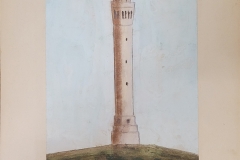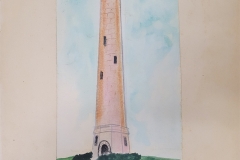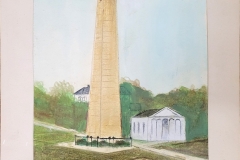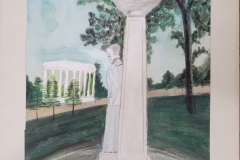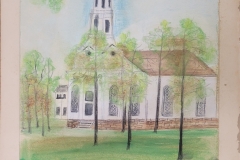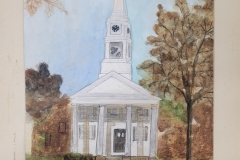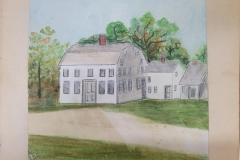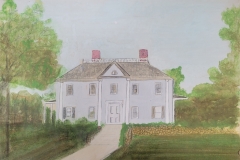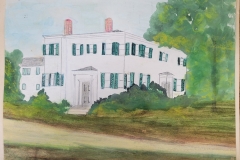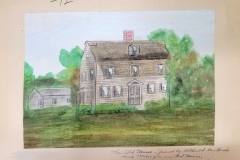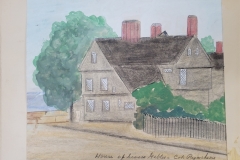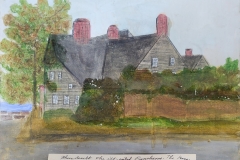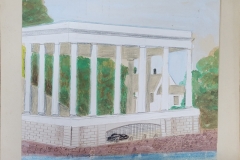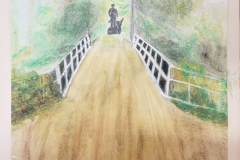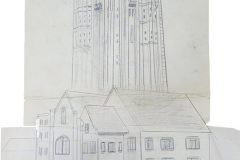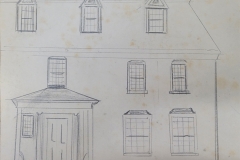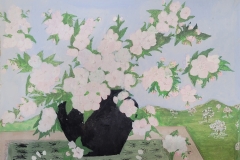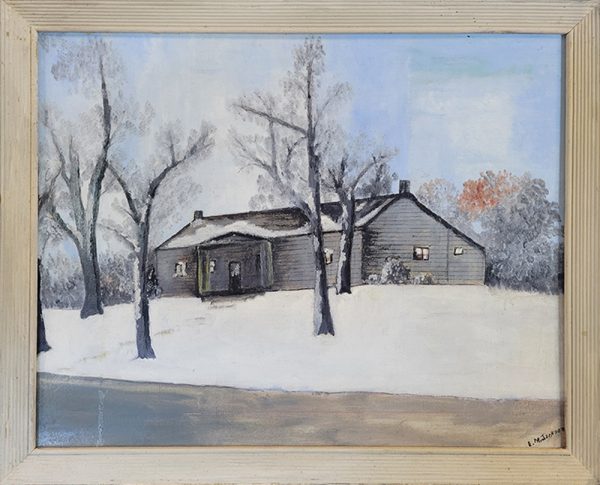 The Pulaski County Historical Society is in possession of three framed paintings by local artist Elnora Bader Jackson as well as several other pieces that were not finished or framed.
The Pulaski County Historical Society is in possession of three framed paintings by local artist Elnora Bader Jackson as well as several other pieces that were not finished or framed.
Elnora Jackson, by Betty Burgess
This article was written by Betty Burgess. It was printed in People of Pulaski County, 1983, and is copied as written, including some name misspellings. Some clarifications are included, and this writer has separated the longer paragraphs into shorter ones and added a few headers, all with the intent of clarification.
The piece was ostensibly about the artist, Elnora Bader Jackson, but very little about Mrs. Jackson’s life is shared.
Letter to the Editor
In August of 1968, Elnora Jackson wrote a letter to Mr. Gorrell, publisher of the Pulaski County Journal….
In 1892/93, school in Winamac was held wherever a vacant room could be found. The town’s one school building, standing where the new portion of the library is now located, burned down in March of 1892.
All available downtown business rooms were taken. Mrs. Lida Bennett, teacher of the primary grade, rented out the front room of her home on the corner of Monticello and Jefferson streets.
[We believe this to be a house that sat south of the Marathon station. The house was torn down when the jail was built. The parcel now serves as a parking lot for Marathon customers and county employees.]
For Mr. Jackson’s seventh and eighth grades (the common schools then had nine grades) the school board secured the use of Mrs. Clark’s parlor on Front Street (Riverside Drive). This home is now occupied by Dr. T. E. Kaminski and family.
Mrs. Jackson recalled, “The house where Dr. Kaminski lives was the ‘Old Clark Home,’ where W.E. Jackson and his pupils completed the 1892 term because of the burning of the schoolhouse. I have heard W.E. Jackson comment on the amount of ‘solid walnut’ used in the construction of that house.”
[This is now the Dulin house. It is a two-story white house on the west side of Riverside Drive, midway between Spring and Pearl Streets.]
Elnora Jackson’s Neighborhood
Elnora said, “My home has been at 415 N. Riverside since March 1, 1913. My early acquaintance with this section of Winamac began in 1892, when my parents bought a home at 402 N. Monticello (which was later the Clay Zellers’ home).
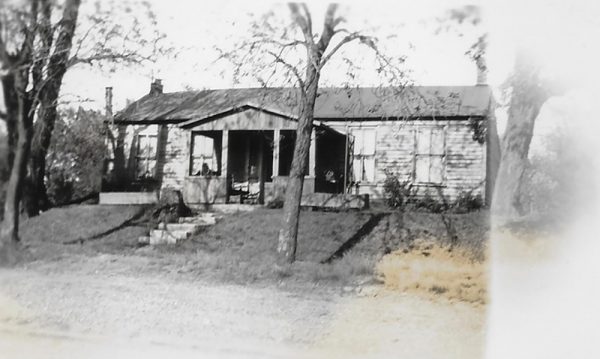
[Pearson/Agnew house] “Where now is the Dr. Overholser home there stood a white-washed, old, very old, one-story house where lived old Mr. and Mrs. Peter Hangley, Irish to the core. They trekked over to a spring, [on the] bank of [the] Tippecanoe, to get their water supply … Carl Riddick (Reddick) bought the Hangley lot and a section (Pearson) of the Tippecanoe riverbank and built the present (Overholser) house.
[Keys house] “The ‘Old Red House’ as ‘Aunt Lizzie Keys’ told it to me:
‘Dr. John Pearson had built a three-room house (soon after 1860), it on Agnew ground, where he and his young bride Elizabeth Agnew were to live. The front room was to be the office and the other two rooms were to suffice for living quarters until enough money came in to build bigger.’
[Dr. Asa Pearson built the home; his father and his son were named John.]
‘Dr. John [sic] Pearson died two years after their marriage. The widow married Edward Keys some years later and they built the house removed when Orland Goble built, on Riverside.’
“My first painting of the J.B. Agnew house went to Helena, Mont., with Mrs. Lucy Cullen, granddaughter, when the Cullens moved to Montana. She asked for it. There the Frank (son) Agnew family had been raised.”
Front Street [now Riverside Drive] by Mr. Gorrell
[Mr. Gorrell speaks of the “Agnew” house, which was originally built by the prominent early white settler to the area, John Pearson. Mr. Pearson is credited with – among other things – naming the town. After Pearson’s death, his widow was unable to maintain payments on the mortgage and the bank foreclosed on the property. The house was purchased from the State by Joseph B. Agnew.]
Mr. Gorrell remembered of Front Street:
“On south of the Agnew home on Front Street were various structures, including a tavern, stables, so that the old Agnew house afforded a view of a village that gradually took on the appearance of a town.
“I don’t remember much about the other house to the south, except that Ed Keys, who had married one of the Agnew girls – Lizzie – occupied a red house that stood on the high bank of the river.
“The street began to show use as a mere sandy trail, extending for a long distance in a direction dictated by the curves of the river at that point. The east side of the street touched the river at two points – one along about Eleventh Street and farther south near the approximate location of the old high school building (County Annex Building).
“When the very first settlers arrived at what was to become the town of Winamac, they inhabited a row of log houses along what was later to be named Front Street. Those who came from the west arrived by ox teams but were attracted to the village by the presence of good drinking water supplied by a spring that flowed into the river from near the river end of what later became Spring Street, past the Methodist Church. Old timers have told me that they remembered when that spring was a common gathering place for new residents of the community.
“Newcomers who arrived from the east approached the river through what is now the baseball park and made a ford up what later became Pearl Street, and from there made their way to the spring at Spring Street.
“The old Agnew home served also as the farm buildings at the southeast corner of the Agnew farm, which was later sold and became the McClelland addition to the town of Winamac.”
Elnora finished the letter to Mr. Gorrell by saying, “When we moved to my present location there were no houses north, only a weed patch up to 11th Street.”
Mrs. Jackson donated her paintings of the old J.R. Agnew house and the Old Red House to the Winamac Historical Society.
Elnora Bader Jackson and William E. Jackson
Elnora Bader was born on December 6, 1873, in Marion County, Ohio, to Mr. and Mrs. Daniel Bader. She was married in 1906 to William E. Jackson….
William E. Jackson was born in 1856, in Sidney, Ohio, and came to this county with his parents in 1863. They settled southeast of Winamac. A capable teacher, Mr. Jackson helped many a boy and girl to a better understanding of the studies which they pursued under his direction. Following several years of teaching in the country and Winamac schools, he was appointed postmaster in 1894, serving until 1899.
Mr. Jackson died March 11, 1922, and Elnora died in September of 1970, at the age of ninety-six years. She, too, was a retired teacher.
This ends the article written by Betty Burgess for People of Pulaski County.
Paintings Donated by Mrs. Jackson to the Pulaski County Historical Society
 Painting of the Pearson House
Painting of the Pearson House
John Pearson built what is thought to be the first frame house in Winamac. Pearson, upon arrival to the area in 1838, moved into a vacated log cabin along the river. Later that year he built a larger log cabin to serve as a home for his wife Edna and their five children. The log cabin was also a trading post and tavern. This frame house was built in front of the log cabin in 1850.
Pearson was a prominent white settler and one of the founders of the town of Winamac, credited with naming the town. He is known as Winamac’s first entrepreneur. He owned the general store, tavern, and sawmill. He also held elected office as Clerk, Recorder, and Auditor.
From Pulaski County Sesquicentennial, Volume I, 1989, “…in 1853, he severed relations with Pulaski County and moved to California where he was killed by Indians one year later.”
Pearson House Becomes Agnew House
The Pearson house is sometimes called the Agnew house. A deed at the Recorder’s Office provides information about the passing of ownership. After John Pearson’s death in California, his widow defaulted on the mortgage, and the State of Indiana took the land. Joseph B. Agnew purchased that SE 1/4 section 11 from the State.
The John Bawcum residence is now at the location of the Pearson-Agnew house, a prominent spot on the west bank of the Tippecanoe River.
[Information from Counties of White and Pulaski, 1883] Joseph B. Agnew came to Pulaski County some years after serving in Company K, Fourth Indiana Volunteers, in the Mexican War. As a colonel, he was injured near National Bridge, thirty miles above Vera Cruz, being shot in the right ankle. This necessitated amputation.
In the fall of 1850, he moved to Pulaski County, settling in Franklin Township. He engaged in farming and stock-raising. He moved to Winamac in 1867, where he owned 137 acres adjoining the town. In 1852, he was elected Clerk and Recorder, which office he held four years and then resigned to become Swamp Land Commissioner. In 1874, he was elected County Treasurer.
One of the twelve children born to Joseph P. and Louisa Agnew was a daughter, Elizabeth (Lizzie).
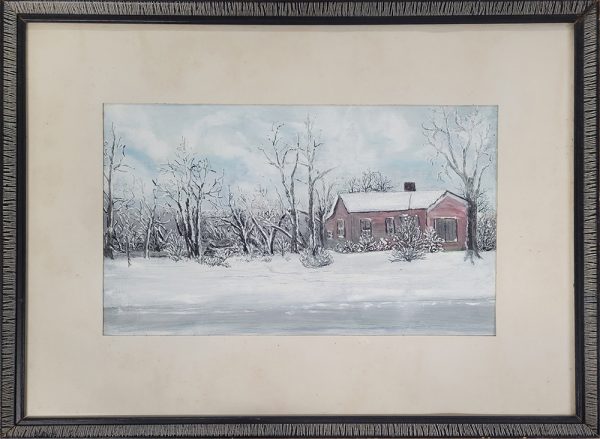 Painting of the Keys House
Painting of the Keys House
This home was built by Dr. Asa M. Pearson, son of John and Edna Pearson, around 1861. The home was on Agnew property, part of the 137 acres of farmland property abutting the north edge of Winamac owned by his wife’s father, Joseph P. Agnew.
At Dr. Pearson’s death two years later, his widow, Elizabeth (Lizzie) Agnew Pearson, married Edward Keys.
This house was located in the 400 block of North Riverside on the west side of the road, where now stands the Goble house. Mrs. Jackson created the oil painting of the house in 1956.
Lizzie was the daughter of a prominent town founder. Edward had the same lineage as the son of Andrew Keys. Andrew Keys, in May 1839, took over the hotel and tavern from John Pearson. He held various elected offices, including that of Associate Judge, a position abolished in the 1850s.
In 1841, Andrew Keys was licensed to keep a ferry across the river at the town. He was required to keep a skiff or canoe for the passage of persons, and a flat boat for the passage of teams and stock. In this position, he was, on many occasions, the first resident to be seen by newcomers who arrived from the east. Those settlers approached the river through what is now the baseball park and made a ford up, or took a ferry across, to what later became Pearl Street.
Painting of the Grist and Flour Mill in Pulaski
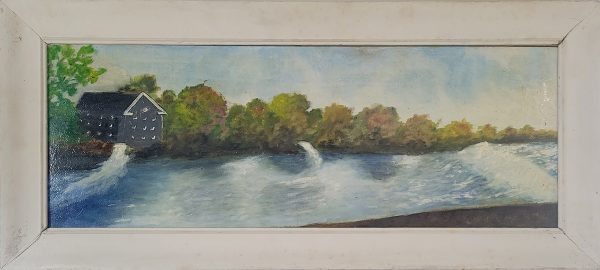
A third painting donated by Ms. Jackson is of the old grist and flour mill on the Tippecanoe River in Pulaski.
The erection of the grist mill began in 1854. Treated like an everyday barn raising, all the local farmers and their families came to help in any way they could. This project was important to the entire community. In 1855, Pulaski County Surveyor I. O. Parrott platted a town next to the mill property that consisted of 56 lots.
The mill was not completed until 1856. The building was three- and one-half stories and encompassed an area of 40 x 60 feet. The race furnished water to three buhrstones, which were later replaced by rollers.
A variety of owners rotated in and out, until Mrs. Jackson’s brother, Clinton L. Bader, bought into the company in 1891. Mr. Bader worked with a variety of partners. In 1905, he sold his shares to J. S. Deitcher for a farm in Illinois. Mr. Deitcher lost his shares back to Mr. Bader, who eventually gave up his shares for good in 1910.
The property was sold in 1912 to a developer who wanted to use the area to generate electricity. Plans fell through and the mill sat empty for several years. On a Monday in July 1920, the Mill was reduced to ashes by a fire.
For additional information about the mill, please link HERE.
Unfinished Works
Mrs. Jackson left a large folder of unframed paintings with the Pulaski County Historical Society. They related to a trip she took to Massachusetts. From her notes, she was researching historical aspects of the Pilgrams, the Revolutionary War, authors, musicians, and churches. Her notes said the paintings were part of a program delivered to a women’s group in “the 1940s.” As she donated her paintings to the Historical Society in the 1960s, it’s possible she did not remember the year of the program.
Of the three framed paintings hanging in the museum, only one is dated (1956). We can assume the others were painted in a similar time frame. In this writer’s humble opinion, the work shows improvement from the unfinished works in the folder.
If the unfinished works were painted in 1940, she would have been 67 years old. She was 83 years old when she painted the “Old Red House.”
This gallery shows only thumbnails. If you wish to see the whole pictures, plus the information about them, CLICK ON THE THUMBNAILS.
